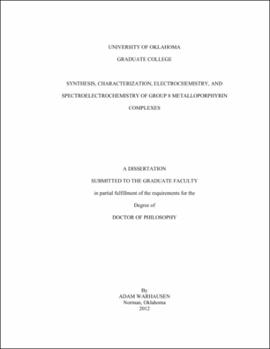| dc.contributor.advisor | Richter-Addo, George B | |
| dc.creator | Warhausen, Adam Jared | |
| dc.date.accessioned | 2019-04-27T21:33:22Z | |
| dc.date.available | 2019-04-27T21:33:22Z | |
| dc.date.issued | 2012 | |
| dc.identifier | 99295672902042 | |
| dc.identifier.uri | https://hdl.handle.net/11244/318994 | |
| dc.description.abstract | This dissertation describes the investigations of nitric oxide (NO) and possible NO donors with group 8 metalloporphyrins. | |
| dc.description.abstract | Chapter one is written in a manner so that the general public could read and understand the work that has been done for this dissertation. | |
| dc.description.abstract | Chapter two describes the redox properties of (por)Ru(CO)(L) (por = tetraphenylporphyrin (TPP), octaethylporphyrin (OEP); L = pyridine and 1-MeIm) complexes. A new technique utilizing chronoabsorptometry and chronoamperometry for investigating short lived "intermediate" species that are formed on the cyclic voltammetric (CV) time scale is used in order to probe the visible region of the electronic spectra of the redox-generated species. This new technique has provided results that are similar to previous reports but now it can be done with shorter scan times (which can minimize decomposition) and less manual manipulation of the data such as subtractions and smoothing. As a result, more detail in the spectrum is obtained by using this new chronoabsorptometry-chronoamperometry technique. Also, we were able to provide the first difference IR spectra for the products generated from their second oxidations. | |
| dc.description.abstract | Chapter three describes the synthesis of new 6-coordinate ruthenium porphyrin nitrosyl aryloxide ((por)Ru(NO)(OR)) complexes (por = OEP, TPP and R = -C6H5 (Ph), -C6H4-2-NHC(=O)CF3 (1HOL), -C6H3-2,6-(NHC(=O)CF3)2 (2HOL), and -NHC(=O)-C6H4-o-OH (SalHate) that show varying amounts (0,1,2) of internal H-bonding. These complexes appear to be good structural models of the heme active site of catalase, which has a tyrosinate ligand coordinated to the iron and internal H-bonds in the active site. They were synthesized by the reaction of the (por)Ru(NO)(O-i-C5H11) or (por)Ru(NO)(OEt) precursor with the appropriate alcohol. The complexes were characterized with the use of 1H NMR, IR, mass spectrometry, cyclic voltammetry, IR spectroelectrochemistry, and UV-vis spectroelectrochemistry. The νNO of 1821 - 1842 cm-1 for these complexes is higher than those of known ruthenium porphyrin nitrosyl alkoxide complexes with νNO ranges of 1790 - 1810 cm-1, most likely due to the conjugation of the phenyl ring found in the aryloxide complexes, which can delocalize electron density. This influences the metal to nitrosyl ligand back-donating ability affecting the N-O bond strength. We also notice a direct correlation of νNO to the number of internal H-bonds in the complexes. The structural information gathered from these new (por)Ru(NO)(OR) aryloxide complexes shows similar characteristics to known structures of the (por)Ru(NO)(OR) alkoxide complexes. The only major difference lies in the ∠RuOR bond angles. The (OEP)Ru(NO)(OR) (R = 1HOL and 2HOL) complexes have ∠RuOR bond angles of 122.26(15) and 124.5(3)º respectively, which are smaller than the reported values of 133.853 - 143.8(5)º. The first oxidation potentials also appear to be increasing with increasing number of internal H-bonds. The cyclic voltammetry for these complexes displays an ECE mechanism. The complexes appear to decompose during the first oxidations, while the second oxidations appear to be taking place on the porphyrin rings due to the observation of the porphyrin π-cation radical peaks in the difference IR spectra. | |
| dc.description.abstract | Chapter 4 describes the synthesis and characterization of 5-coordinate iron porphyrin complexes, where the 5th coordination site is occupied by a hydroxamate, acetate, or aryloxide ligand. The (por)Fe(hydroxamate) complexes (POR = (T(p-OMe)PP) and OEP, R = salicylhydroxamate) showed very unique coordination. The hydroxamate moiety of the ligand, which is typically thought of as a bidentate ligand with respect to iron coordination, was not involved in binding to the metal center. Instead, salicylhydroxamic acid coordinates to the iron center via the phenyl hydroxyl moiety, as determined with X-ray crystallography. The electrochemical investigations of the (por)Fe(acetate) and (por)Fe(aryloxide) complexes each showed two reversible features during oxidation within the solvent limits of the experiments performed which was consistent with reports of known (por)Fe(OR) complexes. The electrochemical behavior of the (por)Fe(salicylhydroxamate) complexes provided more complicated cyclic voltammograms. This was most likely due to instability of the complexes upon oxidation. Infrared spectroelectrochemical investigations of the (por)Fe(salicylhydroxamate) complexes provided difference spectra which suggest the formation of a cationic [(por)Fe(NO)]+ complex upon oxidation. This was due to the new bands in the IR spectrum at 1839 cm-1 and 1855 cm-1 for the (T(p-OMe)PP)Fe(salicylhydroxamate) and (OEP)Fe(salicylhydroxamate) complexes respectively. This is the first report of a coordinated hydroxamate donating NO. The reactivity of the (por)Fe(OR) complexes with nitrite and NO, which suggest the formation of new (por)Fe(NOX)y complexes, are also discussed in this chapter. | |
| dc.format.extent | 151 pages | |
| dc.format.medium | application.pdf | |
| dc.language | en_US | |
| dc.relation.requires | Adobe Acrobat Reader | |
| dc.subject | Porphyrins | |
| dc.subject | Nitric oxide | |
| dc.subject | Nitrosoamines | |
| dc.subject | Hemoproteins | |
| dc.title | SYNTHESIS, CHARACTERIZATION, ELECTROCHEMISTRY, AND SPECTROELECTROCHEMISTRY OF GROUP 8 METALLOPORPHYRIN COMPLEXES | |
| dc.type | text | |
| dc.type | document | |
| dc.thesis.degree | Ph.D. | |
| ou.group | College of Arts and Sciences::Department of Chemistry and Biochemistry | |
